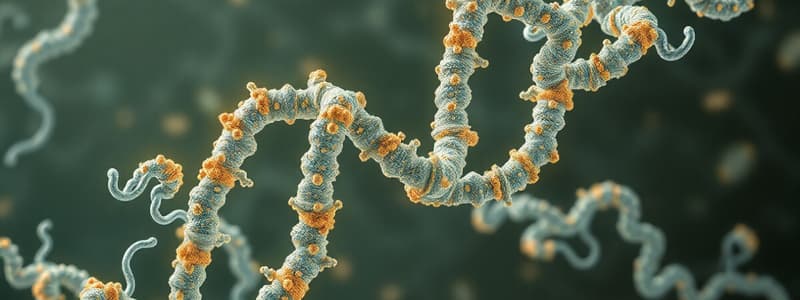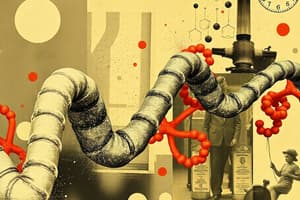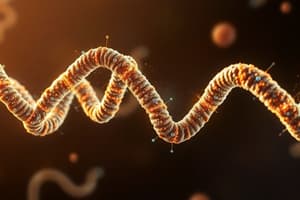Podcast
Questions and Answers
What is the typical arrangement of strands in an alpha/beta domain?
What is the typical arrangement of strands in an alpha/beta domain?
- Single beta strands without helical connections
- Interspersed beta strands with connecting helical segments (correct)
- Purely alpha helices without beta strands
- Only parallel strands
Which type of domain is characterized by separate beta sheets and alpha helices?
Which type of domain is characterized by separate beta sheets and alpha helices?
- Alpha/beta domains
- Quaternary structure domains
- Cross-linked domains
- Alpha+beta domains (correct)
What type of stabilization is primarily seen in cross-linked domains?
What type of stabilization is primarily seen in cross-linked domains?
- Hydrophobic interactions
- Disulfide bridges (correct)
- Peptide bonds
- Ionic bonds
Which structural feature is essential for the stability of hetero-oligomers in quaternary structures?
Which structural feature is essential for the stability of hetero-oligomers in quaternary structures?
Which type of beta sheet is most commonly observed in alpha+beta domains?
Which type of beta sheet is most commonly observed in alpha+beta domains?
What contributes to the stability of the intermolecular interfaces in quaternary protein structures?
What contributes to the stability of the intermolecular interfaces in quaternary protein structures?
What is a defining characteristic of alpha/beta barrel structures?
What is a defining characteristic of alpha/beta barrel structures?
Which type of interaction is involved in stabilizing metal ion cross-linked domains?
Which type of interaction is involved in stabilizing metal ion cross-linked domains?
Which amino acids are typically favored in the formation of alpha helices?
Which amino acids are typically favored in the formation of alpha helices?
Which amino acids are generally disfavored in beta sheet formation?
Which amino acids are generally disfavored in beta sheet formation?
How do nonpolar side chains contribute to the tertiary structure of proteins?
How do nonpolar side chains contribute to the tertiary structure of proteins?
In membrane proteins, where are the polar side chains typically found?
In membrane proteins, where are the polar side chains typically found?
What is the primary role of long stretches of amino acids between secondary structural elements?
What is the primary role of long stretches of amino acids between secondary structural elements?
What is a characteristic feature of beta sheets?
What is a characteristic feature of beta sheets?
What structural arrangement do proteins utilize to avoid interactions between polar groups and nonpolar lipid tails in membranes?
What structural arrangement do proteins utilize to avoid interactions between polar groups and nonpolar lipid tails in membranes?
What term describes the tendency and unreliable predictions regarding preferences of amino acids in secondary structural elements?
What term describes the tendency and unreliable predictions regarding preferences of amino acids in secondary structural elements?
Which of the following is NOT a common structural element of secondary protein structure?
Which of the following is NOT a common structural element of secondary protein structure?
What defines the overall stability of an alpha helix?
What defines the overall stability of an alpha helix?
Which of the following statements about beta sheets is correct?
Which of the following statements about beta sheets is correct?
Which amino acid is most commonly found in the turns of beta sheets?
Which amino acid is most commonly found in the turns of beta sheets?
In tertiary structure, which interactions contribute significantly to protein folding?
In tertiary structure, which interactions contribute significantly to protein folding?
What is the role of phi and psi torsion angles in protein structure?
What is the role of phi and psi torsion angles in protein structure?
Which of the following is a characteristic of alpha helices?
Which of the following is a characteristic of alpha helices?
What type of protein structure does the Ramachandran plot primarily illustrate?
What type of protein structure does the Ramachandran plot primarily illustrate?
Flashcards
Alpha/beta domains
Alpha/beta domains
Protein domains with beta strands connected by alpha-helices. Common shapes include barrels and twists.
Alpha+beta domains
Alpha+beta domains
Protein domains combining separate beta sheets and alpha helices, without a clear organizing pattern.
Cross-linked domains
Cross-linked domains
Protein domains stabilized by disulfide bridges (outside cell) or metal ions (inside cell), with little secondary structure.
Quaternary structure
Quaternary structure
Signup and view all the flashcards
Hetero-oligomers
Hetero-oligomers
Signup and view all the flashcards
Homo-oligomers
Homo-oligomers
Signup and view all the flashcards
Protein subunit symmetry
Protein subunit symmetry
Signup and view all the flashcards
Quaternary structure stabilization
Quaternary structure stabilization
Signup and view all the flashcards
Peptide Bond
Peptide Bond
Signup and view all the flashcards
Peptide bond resonance
Peptide bond resonance
Signup and view all the flashcards
Ramachandran plot
Ramachandran plot
Signup and view all the flashcards
Protein Structure Stabilization
Protein Structure Stabilization
Signup and view all the flashcards
Secondary Structure Elements
Secondary Structure Elements
Signup and view all the flashcards
Beta sheets
Beta sheets
Signup and view all the flashcards
Alpha helices
Alpha helices
Signup and view all the flashcards
Stabilization interactions
Stabilization interactions
Signup and view all the flashcards
Beta turn
Beta turn
Signup and view all the flashcards
Hydrophobic effect
Hydrophobic effect
Signup and view all the flashcards
Membrane protein structure
Membrane protein structure
Signup and view all the flashcards
Hydrophobic interior of membranes
Hydrophobic interior of membranes
Signup and view all the flashcards
Polar head-group layers membrane
Polar head-group layers membrane
Signup and view all the flashcards
All-helical/all-beta-barrel membrane proteins
All-helical/all-beta-barrel membrane proteins
Signup and view all the flashcards
Study Notes
Protein Structure
- Proteins are composed of amino acids linked by peptide bonds
- Peptide bond formation involves a covalent bond between the carboxyl group of one amino acid and the amino group of another
- Peptide bonds exhibit resonance, resulting in a partial double-bond character and limiting rotation
- Torsion angles (φ and ψ) are crucial for protein structure, and steric constraints constrain possible combinations of these angles
- The Ramachandran plot visually represents allowed combinations of phi and psi angles for amino acid residues
- Stability of folded proteins primarily relies on noncovalent interactions (van der Waals forces, hydrogen bonds, and salt bridges)
- Covalent interactions (peptide bonds, and disulfide bridges) also contribute to stabilization
- Secondary structure includes common elements like alpha helices and beta sheets
- Alpha helices are characterized by hydrogen bonds between every fourth amino acid residue creating a right-handed helix
- Beta sheets consist of extended planar structures, held together by hydrogen bonds between adjacent polypeptide backbones
- The arrangement of secondary structural elements into specific motifs (e.g., four-helix bundles, beta barrels) contributes to tertiary structure
- Tertiary protein structure is the three-dimensional arrangement of the polypeptide chain
- The folding of proteins relies on interactions of hydrophilic and hydrophobic amino acid residues with the surrounding aqueous environment
- Membrane proteins have specific structural features to interact with hydrophobic membrane interiors
- Proteins maintain dynamic stability through conformational changes
- Protein stability is influenced by post-translational modifications
- Proteins are composed of various domains and motifs, which contribute to specific functions.
Protein Domains
- Globular proteins often consist of several domains
- Domains frequently fold independently, retaining functional activity
- A limited number of protein folds exists with varying amino acid sequences but similar structural characteristics
Protein Motifs
- Sequence motifs involve specific amino acid sequences with characteristic purposes
- Zinc finger motifs are examples of sequence motifs often in DNA-binding proteins
- Structural motifs are groups of sequential secondary structures; domains are comprised of motifs
- Four-helix bundles and beta-barrels are examples of structural motifs
Classes of Domain Folds
- Alpha domains consist solely of alpha helices
- Beta domains entirely composed of beta sheets, typically antiparallel
- Alpha/beta domains contain both alpha helices and beta sheets, often with specific arrangements, e.g. alpha/beta barrel
- Alpha+beta domains comprise both alpha-helices and beta-sheets,without a specific arrangement pattern
- Cross-linked domains, often have little to no secondary structure, their folding stabilized via disulfide bridges or metal ions
Quaternary Structure
- Quaternary structure refers to the arrangement of multiple polypeptide chains, known as subunits, within a single protein complex
- Protein complexes can exhibit various symmetries (e.g., dimer, trimer, tetramer) based on subunit arrangements
- Intermolecular interactions (e.g., hydrophobic and hydrogen interactions, salt bridges) ensure that subunits come together
- Multiple identical or distinct subunits assemble into higher-order structures. Each protein has a unique quaternary structure
Protein Flexibility
- Protein flexibility is crucial for their function
- Fluctuations, collective motions of neighbouring groups of atoms, domain movements, and ligand-induced changes in conformation are examples of protein flexibility
- Dynamic movements of the protein contribute to substrate binding, catalysis, and signalling
Protein Stability
- Protein chains are only marginally stable, which is essential for flexibility and function
- Disruption of protein structure can occur via thermal or chemical denaturation
- Post-translational modifications (e.g., glycosylation, phosphorylation) can affect protein stability and function
Studying That Suits You
Use AI to generate personalized quizzes and flashcards to suit your learning preferences.




